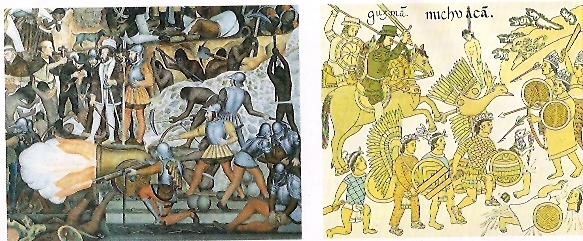| Spanish Empire- The Aztec Campaign 1.2 |
|
The Spanish entry into Mesoamerica
was a complete surprise to the Aztecs. There was much speculation as to the
purpose and intent of the Spaniards' presence. The Aztec's uncertainly of the
Spanish bought time for Cortes and his men to survey their surroundings and
determine the best course of action. The intent of the Spanish was to conquer
in the name of God, glory and economic empire. Accomplishing this task would be
difficult due to the fact that the Spaniards were outnumbered.
Cortes allied with the smaller tribes, such as the Tlaxcalans, who wished to
free themselves from the rule of the Aztec empire. In 1519, with the help
of the allied tribes, Cortes moved on the capital city of Tenochtitlan to capture the Aztec Ruler
Montezuma. (Tignor. 98) By controlling Montezuma, Cortes kept order over the
Indian populace. Despite the Spanish strategy, civil unrest ensued shortly
thereafter. |
|

Figure 1-3 (left) The Conquest of the Aztecs.
This is Diego Rivera's idealized account of the Spanish defeat of the Aztec
warriors. It portrays Spanish soldiers with muskets and horses mowing down
brave, but technologically outgunned Indians. Of course, Rivera’s efforts to
accentuate Spanish brutality led him to exclude important factors in the fall
of Tenochtitlan:
Aztec rivals who joined with Spaniards and diseases. In fact, guns and horses
were important, but not decisive in the Spanish conquest. (right) This image of
the conquest was drawn by a converted Indian later in the sixteenth century and
relied on indigenous oral histories and familiar artistic forms. Observe the
importance of Indians fighting Indians, and the conventional frontal images of
bodies with profiles of heads. (Tignor. 98) |
|
| In the quest for glory, the Spanish used any
means necessary in order to succeed. Though heavily outnumbered, conquistadors
employed their advanced technology of weaponry to succeed in
the field of battle. Alliances with lesser Indian tribes turned Indian against
Indian. Many Indians on both sides were put to the sword for the sake of
securing a future in the Americas Spanish interests. Superior strategy was the
key to victory for the conquistadors. As a result, Spanish imperialism became permanently
engraved in the future of Mesoamerican society. |
|

Figure 1-4 Disease and Decimation of Indians. The real conqueror of American Indians was not so much guns as germs. Even
before Spanish soldiers seized the Aztec capital, germs had begun
decimating the population. The first big killer was in fact smallpox,
recorded here by an Indian artist, covering the bodies of victims.
(Tignor. 101) |
|
Steel and gunpowder weren't the only factors that ensured
success.
There was a much more lethal agent at work helping to harness the
objectives of Spanish Imperialism. With the arrival of the Spanish in
Mesoamerican came the introduction of disease. Europeans carried with
them various forms of sickness which were introduced in the new world.
The immune system of the Indians could not adapt quick enough to the
antibodies that were released upon them with the arrival of the
Spanish. Overtime, the Spanish faced less and less resistance because
of the amount of Indian population that was dying from European
diseases. This is a sight that is little mentioned or recorded in the
propaganda of 16th century Spanish Imperialism. Few images during this
time period captured the suffering of the Indian as a result of
European presence. This image is a visual narrative account of the
agony and hardships which many a native had to endure.
"All told, the foreign pathogens wiped out up to 90 percent of the
Native American population (between 80 and 100 million in 1492)."
(Tignor. 102) |
|
Next
Back |
|

